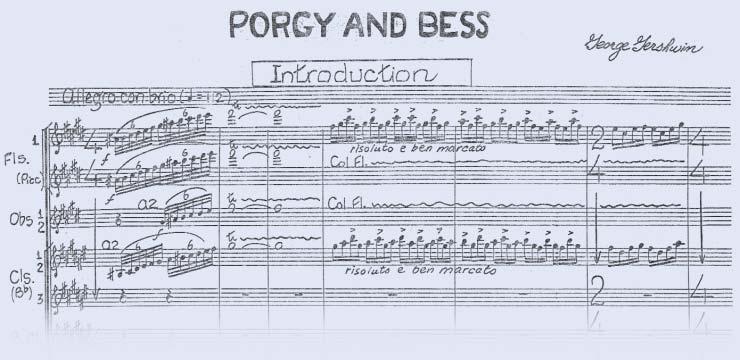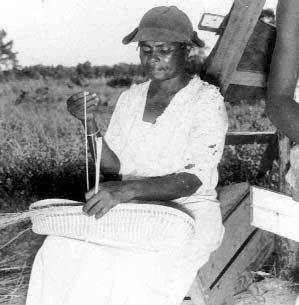
Selected
Characters from Porgy and Bess
By George Gershwin,DuBose and Dorothy Heyward,and Ira GershwinA STUDENT’S GUIDE TO THE OPERALOOK-IN
Synopsis

Act I – Catfish Row, South Carolina, 1950s

It is evening in Catfish Row, an African-American crowded, waterfront section of town in Charleston, South Carolina. Jasbo Brown is playing the blues on the piano as people dance. Clara sings a lullaby (“Summertime”) to her baby while streetwise Sportin’ Life, Clara’s husband Jake, Mingo, Robbins, and some of the other men are gambling. Porgy, who is disabled, enters. The game gets heated as tensions rise between losers and winners. The big bully, Crown, kills Robbins, leaving his girlfriend, Bess, behind. Sportin’ Life then asks Bess to go to New York with him, but she refuses.
Helpless, Bess looks for a safe place to hide, but the religious women of Catfish Row close their doors to her. Only Porgy will give her shelter when the police arrive. The community raises money for Robbins’ funeral. Local resident Peter is arrestedfor killing Robbins. The undertaker consoles Robbins’ wife, Serena, by promising to give Robbins a decent burial.
Act II – Catfish Row, one month later
Jake and the fisherman get ready to take Jake’s boat out. Clara begs her husband not to go. Porgy leans out his window singing “I Got Plenty O’ Nuttin’.” As the rest of Catfish Row gets ready for a picnic on Kittiwah Island, Sportin’ Life again tries to tempt Bess to go with him to New York. She refuses. Porgy warns him to stay away from Bess. Sportin’ Life leaves. Porgy sings “Bess, You Is My Woman.” Everyone is excited about the picnic. Porgy and Maria encourage Bess to go to the picnic. Unable to make the trip,

 Porgy- a disabled beggar (bass-baritone)
Bess- Crown’s girlfriend (soprano)
Clara- Jake’s wife (soprano)
Maria- a shopkeeper (contralto)
Sportin’ Life- the neighborhood hustler (tenor)
Mingo- a Catfish Row resident (tenor)
Porgy- a disabled beggar (bass-baritone)
Bess- Crown’s girlfriend (soprano)
Clara- Jake’s wife (soprano)
Maria- a shopkeeper (contralto)
Sportin’ Life- the neighborhood hustler (tenor)
Mingo- a Catfish Row resident (tenor)
Porgy remains home, but is content with his newfound happiness with Bess.
At the picnic, the Catfish Row community has a wonderful time. The Catfish Row residents are entertained by Sportin’ Life until Serena steps in. As everyone is leaving the island, Crown comes out of hiding to take Bess back. Bess fights with Crown and tells him that she is Porgy’s woman now. Unable to resist Crown, Bess misses the boat back to Catfish Row.
A week later, Peter is released from jail, yet he never knows why he was arrested. Bess has returned home feverish from Kittiwah Island. Serena prays for her health. Bess wakes from her fever, talks with Porgy, and then expresses her love for him (“I Loves You, Porgy”). Porgy promises to protect her from Crown. The hurricane alarm bell sounds.
The community huddles in Serena’s room during the storm. The door bursts open and Crown is standing in the doorway. The community prays to make Crown leave. Jake’s boat turns upside down in the river. Clara hands her baby to Bess and rushes out into the storm calling for Jake. Bess calls out for a man to go after Clara. Crown says that Porgy is not a real man, since he cannot rescue Clara. Then, Crown goes out into the storm. The other residents of Catfish Row pray for the storm to end.
Act III – Catfish Row, the next evening
It is the night after the hurricane. The residents of Catfish Row sing a prayer for all those lost in the storm—Clara, Jake, and Crown. As Crown sneaks back to Catfish Row, Porgy catches him by surprise and kills him.
The police detective wants Porgy to identify Crown’s body. Porgy is arrested. Sportin’ Life tells Bess that Porgy will be locked up for a long time and that she should begin a new life with him in New York (“There’s A Boat Dat’s Leavin’ Soon For New York”). Bess is upset, but finally agrees to go to New York.
Porgy returns from jail. He does not understand why the people look so sad. He calls for Bess but she does not answer. Frantic, he cries out to her. Maria and Serena tell him that Bess was tricked by Sportin’ Life and ran off with him to New York. Porgy does not give up on Bess. He leaves for New York to find Bess (“Oh Lawd, I’m On My Way”).

George Gershwin (1898-1937)
George Gershwin was born at the end of the 19th century, during the term of William McKinley, the 25th President of the United States. Born Jacob Gershowitz in Brooklyn, New York, on September 26, 1898, George was the son of immigrants who came to the United States from St. Petersburg, Russia. When he was six years old, George Gershwin was captivated by Anton Rubinstein’s Melodie in F, which he heard played on a piano roll (an automatic piano) in a Harlem penny arcade (like today’s video arcades). At Public School 25, he listened to fellow student Maxie Rosenzweig, who was eight at the time, playing Antonín Dvorˇák’s Humoresque on the violin. Gershwin would later talk about this powerful moment: “It was, to me, a flashing revelation of beauty.”


When George was 13, the Gershwin family purchased a secondhand piano for George’s older brother, Ira. At age 15, George was offered a job in Broadway’s famed “Tin Pan Alley” playing the piano to sell songs. By the time George was 18, his first original song was published. In addition to Porgy and Bess, his most famous works include Rhapsody in Blue and the songs “’S Wonderful” and “I Got Rhythm.”
Porgy and Bess opened in 1935 in New York and Boston to mixed reviews. Two years later, just weeks before his 39th birthday, George Gershwin passed away in Hollywood, California, on July 11, 1937.

(L to R) Ira Gershwin,George Gershwin,their younger brother Arthur Gershwin, and their cousin,Rose Lagowitz.

Lyricist Librettists
Ira Gershwin (1896-1983)
Born in New York’s Lower East Side on December 6, 1896 as Israel Gershowitz, Ira Gershwin started to write lyrics while he was a student at Townsend Harris High School in New York. In 1918, Ira began using a pen name, Arthur Frances, after the first name of his youngest brother and the first name of his only sister. Not until 1924, when the Gershwin brothers wrote the musical, Lady, Be Good!, was Ira ready to create the long-standing collaboration with George and drop his pen name.
Ira received many nominations of excellence from the Academy of Motion Picture Arts and Sciences (the Oscars), and even received the Pulitzer Prize for Drama for writing the musical comedy Of Thee I Sing in 1932. This was the first musical to ever win the Pulitzer Prize. The final project on which the Gershwin brothers worked together was Porgy and Bess.
After the passing of his brother, Ira went on to collaborate with more composers. Before his own death, Ira created the Gershwin Archive at the Library of Congress to preserve the Gershwin works. Ira Gershwin died in his Beverly Hills, California, home on August 17, 1983.
The First Porgy and Bess

DuBose Heyward (1885-1940)
and Dorothy Heyward (1890-1961)
On August 31, 1885, Heyward was born Edwin DuBose Heyward in Charleston, South Carolina. He was the son of a mill hand from an upper class Southern family, once-wealthy plantation owners who lost their money after the Civil War. DuBose attended both private and public schools, but began working at the age of 14 in a hardware store. As a young man, DuBose also worked as a checker for a steamship company alongside stevedores (people who load and unload ships, like Crown in Porgy and Bess).
Frequently sick as a child, DuBose contracted polio when he was 18. Always interested in literature, he passed the time in his sickbed writing verses, stories, and poetry. At 21, DuBose and a friend organized a real estate and insurance company. Once he had the financial resources to support his writing, DuBose started to pursue his writing more seriously.
DuBose’s first major published work was Porgy (1925), the book that inspired the opera. The Heywards’ stage adaptation of Porgy opened in 1927. Dorothy Heyward wrote other plays including South Pacific (1943), which later became a famous musical.
George Gershwin knew that selecting the singers for Porgy and Bess would not be easy. His music required vocalists who had classical training, but were also comfortable singing jazz rhythms and tones.
After having traveled nationwide to hear singers, Mr. Gershwin invited the opera singer, Todd Duncan, to his apartment to audition for the role of Porgy. After Mr. Duncan sang just twelve bars of the Italian art song, “Lungi dal caro bene,” Gershwin asked him, “Will you be my Porgy?” That was it!
George Gershwin found his Bessin Anne Wiggins Brown. For her audition, she sang the Negro spiritual, “A City from Heaven,” unaccompanied (without a piano). She was the first Bess in 1935, sang the role again in 1942, and performed it in the 1945 movie about Gershwin’s life, Rhapsody in Blue

Did you Know?
Both Todd Duncan and Anne Wiggins Brown lived right here in the nation’s capital! Born in Danville, Kentucky in 1903, Todd Duncan was already a famous bass-baritone (the middle male singing voice) and was teaching voice at Howard University in Washington, D.C. when Gershwin heard of him. In 1945, Duncan became the first African-American singer to perform at New York City Opera.
Born in 1915 to a wealthy Baltimore family, Anne Wiggins Brown attended the Peabody Conservatory (Baltimore) and Juilliard School of Music (New York). It has been said that without Ms. Brown, Porgy and Bess might be known by its original name, Porgy. Anne Wiggins Brown was able to convince George to rewrite the third act so that she could sing “Summertime” (the character Clara also sings “Summertime” in act one) and to change the title of the opera to Porgy and Bess
Lights! Camera! Action!
Well-known stars from the opera world and Hollywood have played the characters in Porgy and Bess both on stage and in the movie based on the opera, which came out in 1959.
All-around entertainer who danced, sang, told jokes, and played many musical instruments.
Ruby(opera): MayaAngelou
Bess (film): Dorothy Dandridge
Opera singer and actor from the popular 1970s1980s television show, The Jeffersons.
Singer,songwriter, and bandleader known for his jazzy scat vocal style.
Porgy (film): Sidney Poitier
First African-American to be nominated for the Academy Award for Best Actress for the film, Carmen Jones, which was inspired by the Bizet opera, Carmen.
Sportin’ Life (opera): Cab Calloway
Entertainer and United States Goodwill Ambassador to the United Nations.
Sportin’Life(opera): DamonEvans
International opera star.
Maria(film):PearlBailey
Bess (opera):Leontyne Price

Sportin’ Life (film): Sammy Davis, Jr.
 Clara (film): Diahann Carroll
Clara (film): Diahann Carroll
Actor who was the first AfricanAmerican man to win an Academy Award for Best Actor. First AfricanAmerican actress in television history to star in her own show.





